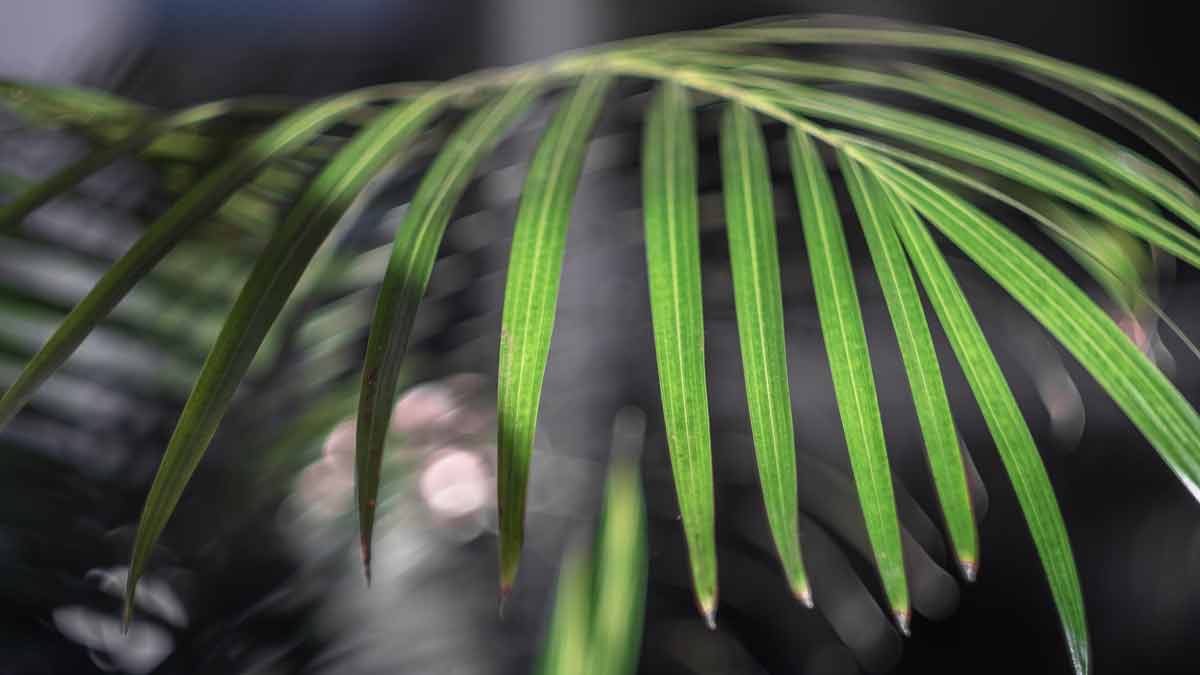Majestically tall and stately, the majesty palm (Ravenea rivularis), also known as the Majestic palm, is a stunning houseplant that commands attention in any indoor space.
However, this regal beauty is notoriously finicky, and even experienced growers can have trouble keeping it alive and healthy.
One of the most common problems plaguing majesty palms is underwatering, which can cause various issues, including yellowing leaves, brown leaf tips, and wilting.
Here’s what you need to know about underwatered majesty palms, how to identify it, and how to fix the problem.
Why Is Underwatering Majesty Palms a Problem?
Majesty palms are native to Madagascar, where they grow in tropical rainforests.
In their natural habitat, these palms are constantly surrounded by moisture, which they absorb through their roots.
When majesty palms are grown indoors, they rely on us to provide them with the right amount of water to keep them healthy.
Underwatering is a problem because it causes the plant’s roots to dry out, preventing them from absorbing the water and nutrients they need to thrive.
Water is essential for several reasons, including:
- Helping the plant to transport nutrients from the soil to the leaves
- It helps create energy and food for the plant
- Regulates the plant’s temperature
- Maintain the plant’s cell structure to prevent wilting
Without adequate water, majesty palms will begin to show signs of stress, which can eventually lead to death.
What Causes Underwatering in Majesty Palms?
There are a few different reasons why your majesty palm might be underwatered.
Here are some of the most common culprits:
Not Enough Water
This is the most obvious cause of underwatering, and it’s often the result of simply forgetting to water your palm.
If you’re busy or traveling, it can be easy to forget to water your plants, so make sure to set a reminder or ask someone to water them for you while you’re away.
It’s also important to check your palm plant regularly to see how dry the soil is. If it feels dry to the touch, it’s time to water.
Incorrect Watering Schedule
Another common cause of underwatering is an incorrect watering schedule.
Many people make the mistake of watering their palms too frequently, which can lead to underwatering.
When the roots are constantly wet, they cannot get the oxygen they need to function correctly, which can eventually kill the plant.
Letting the soil dry out completely between waterings is essential to prevent this.
The best way to know how often to water your palm tree is to check the soil before watering.
If it’s dry, give it a good soak until water begins running out of the pot’s bottom.
Allow the plant to drain completely before putting it back in its spot, and don’t water again until the soil is dry.
Using the Wrong Type of Water
The type of water you use to water your majesty palm can also contribute to underwatering.
Tap water high in chlorine or other chemicals can harm the plant and make it more difficult for the roots to absorb moisture.
It’s best to use filtered or distilled water whenever possible.
Hot, Dry Weather
Hot, dry weather can also cause your majesty palm to become stressed and underwatered.
During the summer, the heat can cause the soil to dry out more quickly, so you may need to water more frequently.
If your palm is outdoors, ensure it’s getting enough shade to prevent the leaves from scorching in the sun.
You may also need to mist the leaves regularly to help keep them hydrated.
Indoor Heating
Indoor heating can also contribute to underwatering.
During the winter, indoor heat can cause the air to become very dry, which can quickly suck the moisture out of your palm’s leaves.
To help combat this, you can use a humidifier in the room where your indoor palm plant is located.
You should also mist the leaves regularly to help keep them hydrated.
Poor Drainage
Another cause of underwatering is poor drainage.
If the pot your palm is in doesn’t have good drainage holes, the roots can become waterlogged and suffocate.
Choose a pot with good drainage, and always use well-draining soil to prevent this from happening.
Majesty palms need a potting soil that drains well but holds some moisture.
You can also add perlite or sand to the soil to help with drainage.
Root-Bound Plants
Root-bound plants are also more prone to underwatering.
When a plant’s roots become tightly packed, they have difficulty absorbing water and nutrients from the soil.
If your palm appears root-bound, you may need to repot it into a larger pot.
Be sure to choose a pot that’s only slightly larger than the current one to prevent the roots from becoming too pot-bound.
Diseases
Certain diseases can also cause underwatering.
For example, root rot is a common problem in palms that are overwatered or have poor drainage.
The plant’s roots become waterlogged and begin to decay, which prevents the plant from absorbing water and nutrients.
Several other diseases can cause underwatering, so it’s essential to look for any signs of disease.
Pests
Pests can also cause underwatering by damaging the roots of the plant.
For example, mealybugs and scale can infest the roots and prevent the plant from absorbing moisture.
If you think your palm tree may be infested with pests, check the roots for any signs of damage.
You may also see insects crawling on the leaves or stems of the plant.
If you suspect your palm has pests, you can try using insecticidal soap or horticultural oil to get rid of them.
How To Tell If Your Majesty Palm Is Underwatered
It’s essential to catch underwatering early on, or else your palm may start to experience irreversible damage.
You can look for several signs to determine whether your majesty palm is underwatered.
Signs of an Underwatered Majesty Palm
The most common signs of an underwatered majesty palm are:
Drooping Leaves
The first sign of underwatering is usually drooping leaves.
When the plant doesn’t have enough water, the leaves will start to droop and wilt.
The plant cannot transport water to the leaves, so they dehydrate.
If you see your palm leaves drooping, check the soil to see if it’s dry.
If the soil is dry, water the plant immediately.
Yellow Leaves
Another sign of underwatering is yellowing leaves.
When the plant doesn’t have enough water, the palm leaves will turn yellow and fall off.
This is because the plant cannot transport nutrients to the leaves, so they die.
Yellowing leaves can also be a sign of other problems, such as pests, diseases, or nutrient deficiencies.
If your palm leaves turn yellow, check the soil to see if it’s dry.
If the soil is dry, water the plant immediately.
Brown Leaf Tips
Another common sign of underwatering is brown leaf tips.
When the plant experiences insufficient water, the tips of the palm tree leaves will become brown and desiccate.
The plant cannot transport moisture to the leaves, so they start dehydrating.
If your palm tree leaves turn brown at the tips, check the soil to see if it’s dry.
If the soil is dry, water the plant immediately.
Curling Leaves
Underwatered majesty palm trees will also have leaves that curl up or inward.
The plant cannot transport water to the leaves, so they dehydrate and curl up.
If you see your majesty palm leaves curling, it’s a sign that the plant is not getting enough water. Make sure to water your palm regularly and deeply to prevent this.
Dry or Cracked Soil
One of the most common telltale signs that your majesty palm is underwatered is dry or cracked soil.
When the soil is too dry, it can cause the roots to become stressed and damaged, leading to a whole host of other problems for the plant.
If you see that the soil around your majesty palm is dry or cracked, it’s time to give it a good watering.
Leaf Drop
Another sign that your majesty palm is not getting enough water is leaf drop.
When the plant doesn’t have enough water, the leaves will start to fall off.
This is because the plant cannot transport moisture to the leaves, so they dehydrate and die.
If you see your majesty palm tree losing leaves, it’s a sign that the plant is not getting enough water.
Make sure to water your palm regularly and deeply to prevent this.
Slow Growth
Underwatered majesty palms will also have slow growth.
When the plant doesn’t have enough water, it will experience stunted growth.
This is because the plant cannot transport water and nutrients to the leaves and roots, so they can’t grow as quickly.
If your majesty palm is not growing as quickly as it should be, check the soil to see if it’s dry.
If the soil is dry, water the plant immediately.
How To Save an Underwatered Majesty Palm
If you think your majesty palm is underwatered, you can do a few things to save it.
Here are some tips on how to save an underwatered majesty palm:
1. Water Deeply and Regularly
One of the best things you can do for your underwatered majesty palm is to water it deeply and regularly.
Ensure to water the plant until the soil is thoroughly wet, and then allow the soil to dry out completely before watering again.
This will help ensure that your palm gets the moisture it needs without overwatering.
2. Use a Humidity Tray
Another great way to help your underwatered majesty palm is to use a humidity tray.
A humidity tray is a shallow tray filled with water and pebbles that you can place under your palm.
The water will evaporate and help increase the humidity around the plant, which can help it recover from underwatering.
3. Use a Mulch
Mulching your majesty palm can also help it recover from underwatering.
Mulch is a material, such as bark or leaves, that you can place around the base of your plant.
Mulch will help to hold in moisture and protect the roots from heat.
4. Move to a Cooler Location
If you think your majesty palm is underwatered, you can try moving it to a cooler location.
Palms prefer warm temperatures, but moving it to a cooler spot can help it recover if the plant is stressed from underwatering.
5. Prune Dead Leaves
If your majesty palm has dead leaves, you can try pruning them off.
Pruning will help the majesty palm to focus its energy on healthy growth and can also help it recover from underwatering.
6. Repot in Fresh Soil
If your majesty palm is in a pot, you can try repotting it in fresh soil.
The soil can become compacted and dry when a plant has been underwatered.
Repotting in fresh soil will help the plant recover its moisture and nutrients.
7. Give It Time
Underwatering can be a stressful experience for your majesty palm, so giving the plant time to recover is essential.
Don’t expect your palm to bounce back overnight.
With proper care and time, your majesty palm will recover from underwatering and return to its old self in no time.
How To Prevent Underwatering a Majesty Palm
While the majesty palm is a tough plant, it’s still susceptible to underwater.
Here are some tips on how to prevent underwatering your majesty palm:
- Check the soil before watering. Stick your finger into the soil up to your second knuckle. If the soil is dry, it’s time to water.
- Water deeply and less often. Water your majesty palm until the water runs out of the drainage holes at the bottom of the pot. Then, wait until the soil is dry before watering again.
- Use a moisture meter. A moisture meter will help you to know exactly when your plant needs water.
- Group plants together. Grouping plants together helps to create a microclimate. The plants will help to regulate the temperature and humidity around each other.
- Place your palm in a saucer of pebbles. Fill a saucer with pebbles and place it underneath your potted palm. Add water to the saucer until the water reaches the top of the pebbles. The water’s evaporation will help raise the humidity around your plant.
- Mist your plant regularly. Use a spray bottle to mist your plant with water. This is especially important in the winter when the air is dry.
- Use a humidifier. A humidifier will help to add moisture to the air, which will help your plant to stay hydrated.
- Use a well-draining soil. A well-draining soil will help to prevent your plant from sitting in water, which can lead to root rot.
- Place your palm in bright indirect light. Indirect sunlight will help your plant to photosynthesize and create food for itself.
- Don’t place your palm in direct sunlight. Direct sunlight can scorch the leaves of your plant.
- Repot your palm every two to three years. Repotting will help refresh the soil and boost your plant’s nutrients.
- Fertilize your palm regularly. Fertilizing will help to give your plant the nutrients it needs to stay healthy.
- Prune your palm regularly. Pruning will help to keep your plant from getting too big and unmanageable.
- Check for pests regularly. Pests can cause a lot of damage to your plant. Check your plant regularly for pests and treat them accordingly.
- Check for diseases regularly. Diseases can also cause a lot of damage to your plant. Check your plant regularly for diseases and treat them accordingly.
Final Thoughts
Majesty palm care is not difficult, but it requires regular maintenance.
Be sure to monitor your plant for signs of under or overwatering and adjust your watering schedule accordingly.
With love and attention, your majesty palm will thrive indoors or out!







